2012 PEUGEOT 5008 warning light
[x] Cancel search: warning lightPage 165 of 340

D
R
163
Stopping the vehicle
Before switching off the engine, you
can engage position P
or N
to place the
gearbox in neutral.
In both cases, apply the parking brake
to immobilise the vehicle, unless it is
programmed to automatic mode.
Operating fault
When the ignition is on, the
lighting of this warning lamp,
accompanied by an audible
signal and a message in the
multifunction screen, indicates
a gearbox malfunction.
In this case, the gearbox switches to
back-up mode and is locked in 3rd gear.
You may feel a substantial knock when
changing from P
to R
and from N
to R
.
This will not cause any damage to the
gearbox.
Do not exceed 60 mph (100 km/h), local
speed restrictions permitting.
Have it checked by a PEUGEOT dealer
or a qualifi ed workshop.
This warning lamp may also come on if
a door is opened.
You risk damaging the gear-
box:
Manual operation
�)
Select position M
for sequential
changing of the six gears.
�)
Push the lever towards the +
sign to
change up a gear.
�)
Pull the lever towards the -
sign to
change down a gear.
D
disappears and the gears
engaged appear in succes-
sion in the instrument panel.
If the lever is not in position P
,
when the driver's door is opened
or approximately 45 seconds af-
ter the ignition is switched off, there is an
audible signal and a message appears.
�)
Return the lever to position P
; the
audible signal stops and the mes-
sage disappears.
It is only possible to change from one
gear to another if the vehicle speed and
engine speed permit; otherwise, the
gearbox will operate temporarily in au-
tomatic mode.
Invalid value during manual
operation
This symbol is displayed if a
gear is not engaged correctly
(selector between two posi-
tions).
It is possible to change from position D
(automatic) to position M
(manual) at
any time.
When the vehicle is stationary or mov-
ing very slowly, the gearbox selects
gear M1
automatically.
The sport and snow programmes do not
operate in manual mode. If the engine speed is too low or too
high, the gear selected fl ashes for a few
seconds, then the actual gear engaged
is displayed.
- if you press the accelerator and
brake pedals at the same time,
- if you force the lever from posi-
tion P
to another position when
the battery is fl at.
To reduce fuel consumption when
stationary for long periods with the
engine running (traffi c jam...), posi-
tion the gear lever at N
and apply
the parking brake, unless it is pro-
grammed in automatic mode.
Page 166 of 340
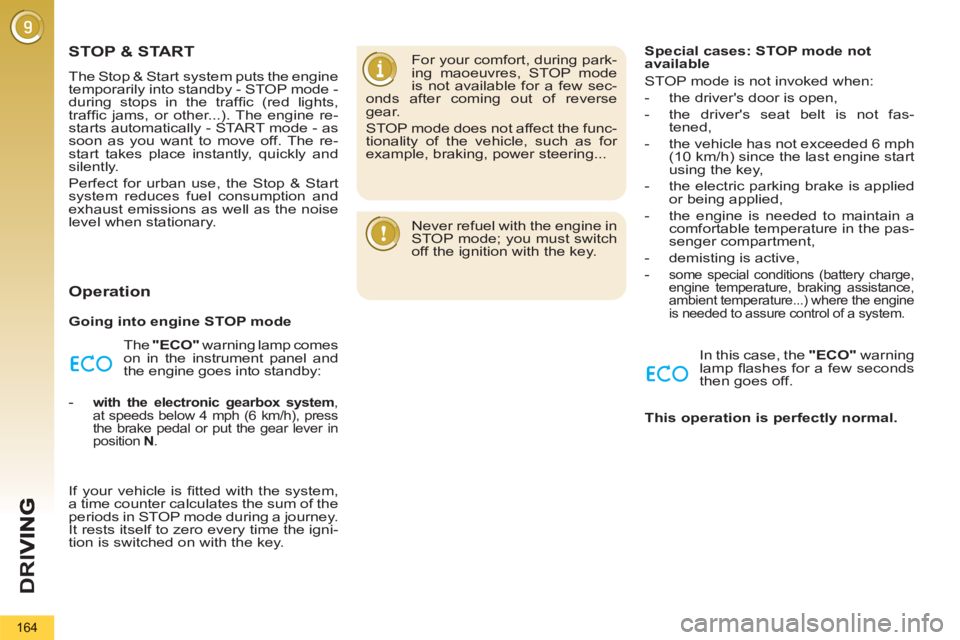
D
R
I
164
STOP & START
The Stop & Start system puts the engine
temporarily into standby - STOP mode -
during stops in the traffi c (red lights,
traffi c jams, or other...). The engine re-
starts automatically - START mode - as
soon as you want to move off. The re-
start takes place instantly, quickly and
silently.
Perfect for urban use, the Stop & Start
system reduces fuel consumption and
exhaust emissions as well as the noise
level when stationary.
Operation
Going into engine STOP mode
The "ECO"
warning lamp comes
on in the instrument panel and
the engine goes into standby:
-
with the electronic gearbox system
,
at speeds below 4 mph (6 km/h), press
the brake pedal or put the gear lever in
position N
.
If your vehicle is fi tted with the system,
a time counter calculates the sum of the
periods in STOP mode during a journey.
It rests itself to zero every time the igni-
tion is switched on with the key.
For your comfort, during park-
ing maoeuvres, STOP mode
is not available for a few sec-
onds after coming out of reverse
gear.
STOP mode does not affect the func-
tionality of the vehicle, such as for
example, braking, power steering...
Never refuel with the engine in
STOP mode; you must switch
off the ignition with the key.
Special cases: STOP mode not
available
STOP mode is not invoked when:
- the driver's door is open,
- the driver's seat belt is not fas-
tened,
- the vehicle has not exceeded 6 mph
(10 km/h) since the last engine start
using the key,
- the electric parking brake is applied
or being applied,
- the engine is needed to maintain a
comfortable temperature in the pas-
senger compartment,
- demisting is active,
-
some special conditions (battery charge,
engine temperature, braking assistance,
ambient temperature...) where the engine
is needed to assure control of a system.
In this case, the "ECO"
warning
lamp fl ashes for a few seconds
then goes off.
This operation is perfectly normal.
Page 213 of 340

PRACTICAL INFORMATION
211
The maximum towed load on a long in-
cline depends on the gradient and the
ambient temperature.
In all cases, keep a check on the cool-
ant temperature.
Braking
Towing a trailer increases the braking
distance.
To avoid overheating of the brakes on a
long mountain type of descent, the use
of engine braking is recommended.
Tyres
�)
Check the tyre pressures of the tow-
ing vehicle and of the trailer, observ-
ing the recommended pressures.
Lighting
�)
Check the electrical lighting and sig-
nalling on the trailer.
The rear parking sensors will
be deactivated automatically if
a genuine PEUGEOT towbar
is used.
�)
If the warning lamp and the
STOP
warning lamp come
on, stop the vehicle and
switch off the engine as
soon as possible.
FITTING ROOF BARS
Maximum authorised weight
on the roof rack, for a loading
height not exceeding 40 cm
(with the exception of bicycle
carriers): 65
kg.
If the height exceeds 40 cm, adapt
the speed of the vehicle to the pro-
fi le of the road to avoid damaging the
roof bars and the fi xings on the roof.
Be sure to refer to national legislation
in order to comply with the regula-
tions for transporting objects that are
longer than the vehicle.
When fi tting transverse roof bars, use
the four quick-fi t fi xings provided for this
purpose:
�)
lift the concealing fl aps,
�)
open the fi xing covers on each bar
using the key,
�)
put each fi xing in place and lock
them on the roof one by one,
�)
ensure that roof bars are correctly
fi tted (by shaking them),
�)
close the fi xing covers on each bar
using the key.
If your vehicle is fi tted with
roof fi nishers, do not use them
for carrying loads.
Page 217 of 340
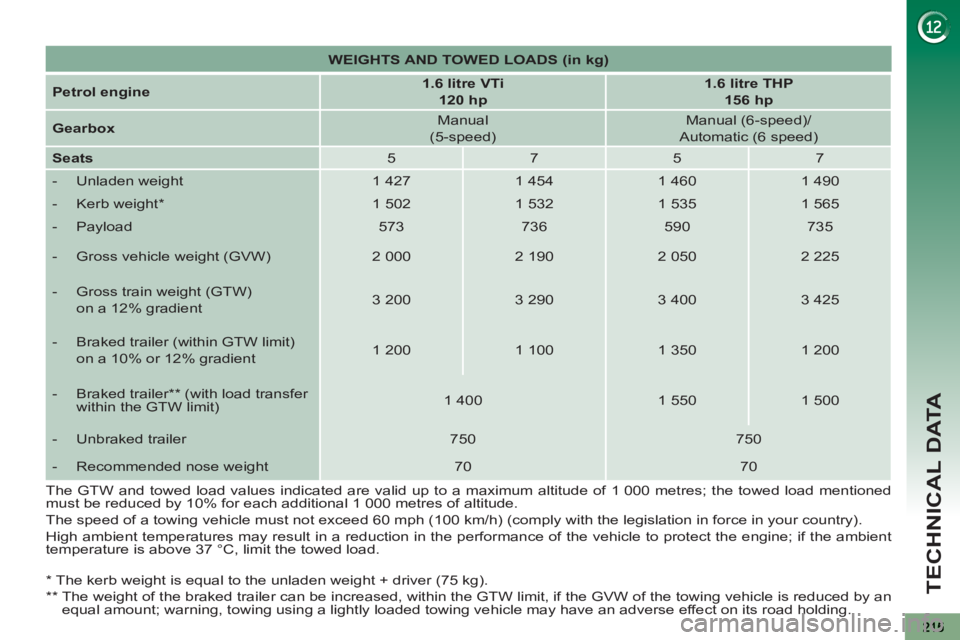
TECHNICAL DATA
*
The kerb weight is equal to the unladen weight + driver (75 kg).
**
The weight of the braked trailer can be increased, within the GTW limit, if the GVW of the towing vehicle is reduced by an
equal amount; warning, towing using a lightly loaded towing vehicle may have an adverse effect on its road holding.
WEIGHTS AND TOWED LOADS (in kg)
Petrol engine
1.6 litre VTi
120 hp
1.6 litre THP
156 hp
Gearbox
Manual
(5-speed)
Manual (6-speed)/
Automatic (6 speed)
Seats
5
7
5
7
- Unladen weight
1 427
1 454
1 460
1 490
- Kerb weight *
1 502
1 532
1 535
1 565
- Payload
573
736
590
735
- Gross vehicle weight (GVW)
2 000
2 190
2 050
2 225
- Gross train weight (GTW)
on a 12% gradient
3 200
3 290
3 400
3 425
- Braked trailer (within GTW limit)
on a 10% or 12% gradient
1 200
1 100
1 350
1 200
- Braked trailer ** (with load transfer
within the GTW limit)
1 400
1 550
1 500
- Unbraked trailer
750
750
- Recommended nose weight
70
70
The GTW and towed load values indicated are valid up to a maximum altitude of 1 000 metres; the towed load mentioned
must be reduced by 10% for each additional 1 000 metres of altitude.
The speed of a towing vehicle must not exceed 60 mph (100 km/h) (comply with the legislation in force in your country).
High ambient temperatures may result in a reduction in the performance of the vehicle to protect the engine; if the ambient
temperature is above 37 °C, limit the towed load.
Page 219 of 340
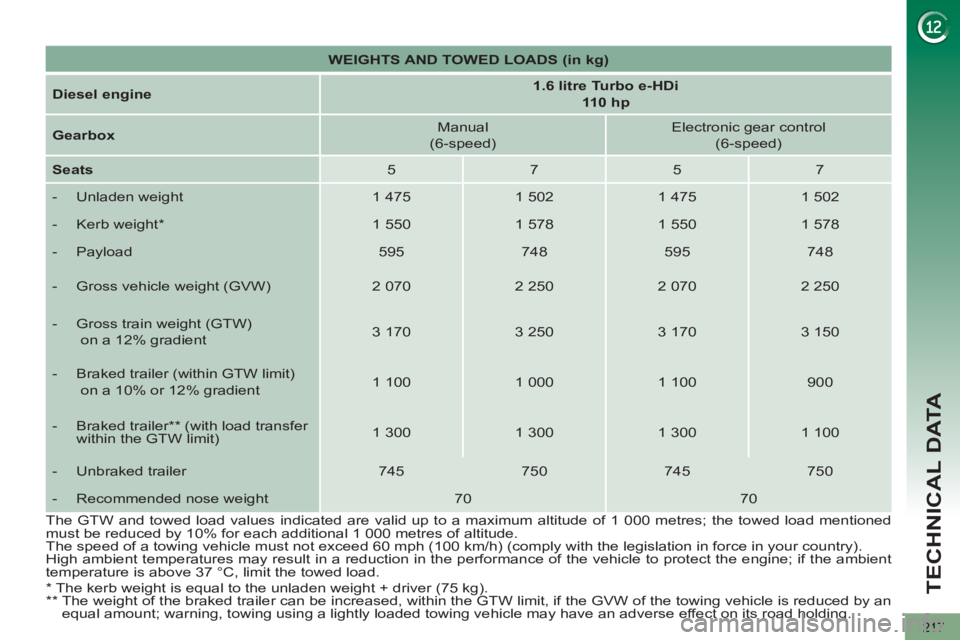
TECHNICAL DATA
217
WEIGHTS AND TOWED LOADS (in kg)
Diesel engine
1.6 litre Turbo e-HDi
110 hp
Gearbox
Manual
(6-speed)
Electronic gear control
(6-speed)
Seats
5
7
5
7
- Unladen weight
1 475
1 502
1 475
1 502
- Kerb weight *
1 550
1 578
1 550
1 578
- Payload
595
748
595
748
- Gross vehicle weight (GVW)
2 070
2 250
2 070
2 250
- Gross train weight (GTW)
on a 12% gradient
3 170
3 250
3 170
3 150
- Braked trailer (within GTW limit)
on a 10% or 12% gradient
1 100
1 000
1 100
900
- Braked trailer ** (with load transfer
within the GTW limit)
1 300
1 300
1 300
1 100
- Unbraked trailer
745
750
745
750
- Recommended nose weight
70
70
*
The kerb weight is equal to the unladen weight + driver (75 kg).
**
The weight of the braked trailer can be increased, within the GTW limit, if the GVW of the towing vehicle is reduced by an
equal amount; warning, towing using a lightly loaded towing vehicle may have an adverse effect on its road holding. The GTW and towed load values indicated are valid up to a maximum altitude of 1 000 metres; the towed load mentioned
must be reduced by 10% for each additional 1 000 metres of altitude.
The speed of a towing vehicle must not exceed 60 mph (100 km/h) (comply with the legislation in force in your country).
High ambient temperatures may result in a reduction in the performance of the vehicle to protect the engine; if the ambient
temperature is above 37 °C, limit the towed load.
Page 220 of 340
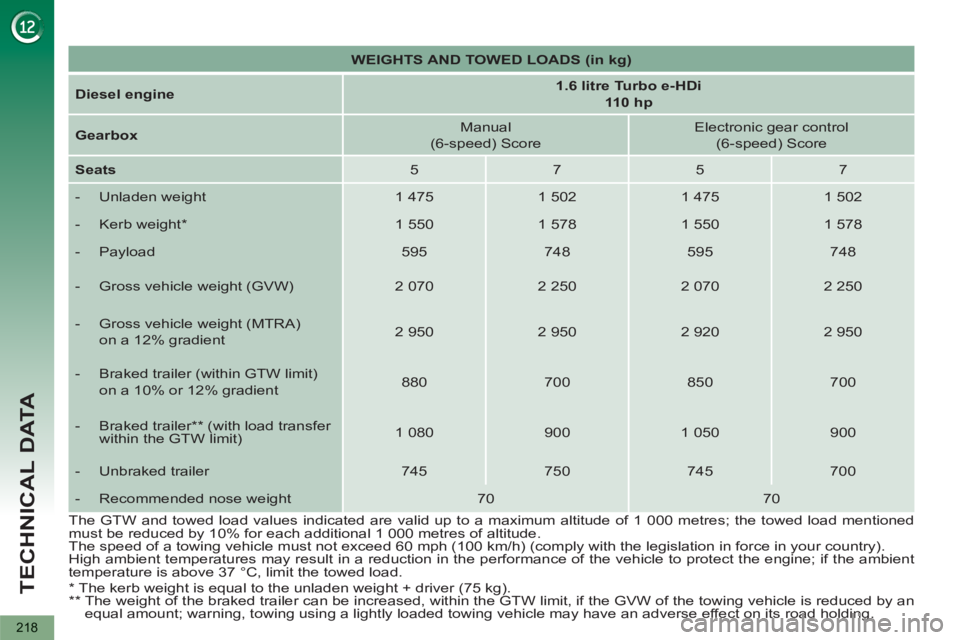
TECHNICAL DATA
218
WEIGHTS AND TOWED LOADS (in kg)
Diesel engine
1.6 litre Turbo e-HDi
110 hp
Gearbox
Manual
(6-speed) Score
Electronic gear control
(6-speed) Score
Seats
5
7
5
7
- Unladen weight
1 475
1 502
1 475
1 502
- Kerb weight *
1 550
1 578
1 550
1 578
- Payload
595
748
595
748
- Gross vehicle weight (GVW)
2 070
2 250
2 070
2 250
- Gross vehicle weight (MTRA)
on a 12% gradient
2 950
2 950
2 920
2 950
- Braked trailer (within GTW limit)
on a 10% or 12% gradient
880
700
850
700
- Braked trailer ** (with load transfer
within the GTW limit)
1 080
900
1 050
900
- Unbraked trailer
745
750
745
700
- Recommended nose weight
70
70
The GTW and towed load values indicated are valid up to a maximum altitude of 1 000 metres; the towed load mentioned
must be reduced by 10% for each additional 1 000 metres of altitude.
The speed of a towing vehicle must not exceed 60 mph (100 km/h) (comply with the legislation in force in your country).
High ambient temperatures may result in a reduction in the performance of the vehicle to protect the engine; if the ambient
temperature is above 37 °C, limit the towed load.
*
The kerb weight is equal to the unladen weight + driver (75 kg).
**
The weight of the braked trailer can be increased, within the GTW limit, if the GVW of the towing vehicle is reduced by an
equal amount; warning, towing using a lightly loaded towing vehicle may have an adverse effect on its road holding.
Page 221 of 340
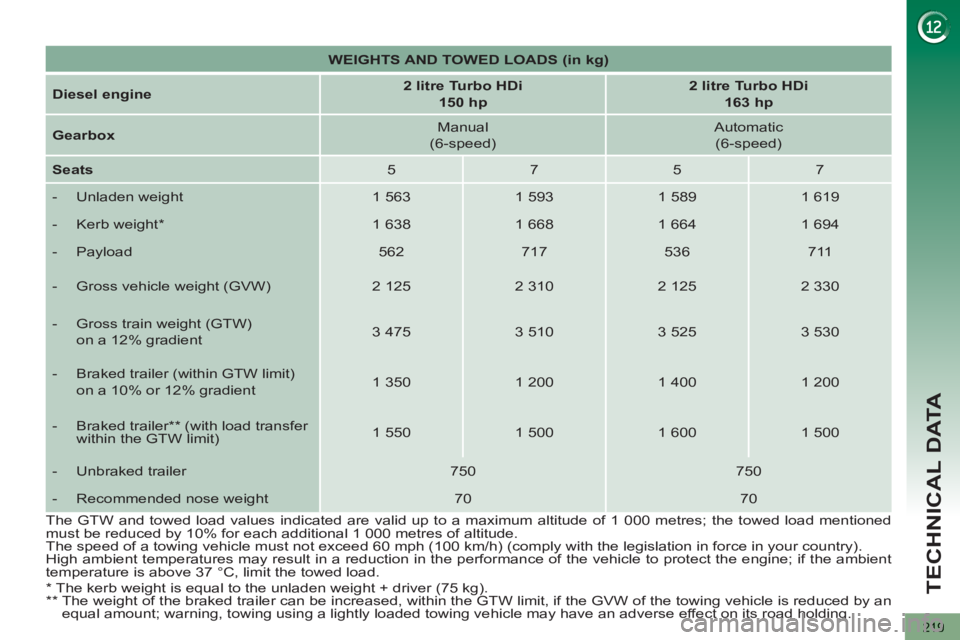
TECHNICAL DATA
219
WEIGHTS AND TOWED LOADS (in kg)
Diesel engine
2 litre Turbo HDi
150 hp
2 litre Turbo HDi
163 hp
Gearbox
Manual
(6-speed)
Automatic
(6-speed)
Seats
5
7
5
7
- Unladen weight
1 563
1 593
1 589
1 619
- Kerb weight *
1 638
1 668
1 664
1 694
- Payload
562
717
536
711
- Gross vehicle weight (GVW)
2 125
2 310
2 125
2 330
- Gross train weight (GTW)
on a 12% gradient
3 475
3 510
3 525
3 530
- Braked trailer (within GTW limit)
on a 10% or 12% gradient
1 350
1 200
1 400
1 200
- Braked trailer ** (with load transfer
within the GTW limit)
1 550
1 500
1 600
1 500
- Unbraked trailer
750
750
- Recommended nose weight
70
70
The GTW and towed load values indicated are valid up to a maximum altitude of 1 000 metres; the towed load mentioned
must be reduced by 10% for each additional 1 000 metres of altitude.
The speed of a towing vehicle must not exceed 60 mph (100 km/h) (comply with the legislation in force in your country).
High ambient temperatures may result in a reduction in the performance of the vehicle to protect the engine; if the ambient
temperature is above 37 °C, limit the towed load.
*
The kerb weight is equal to the unladen weight + driver (75 kg).
**
The weight of the braked trailer can be increased, within the GTW limit, if the GVW of the towing vehicle is reduced by an
equal amount; warning, towing using a lightly loaded towing vehicle may have an adverse effect on its road holding.
Page 222 of 340
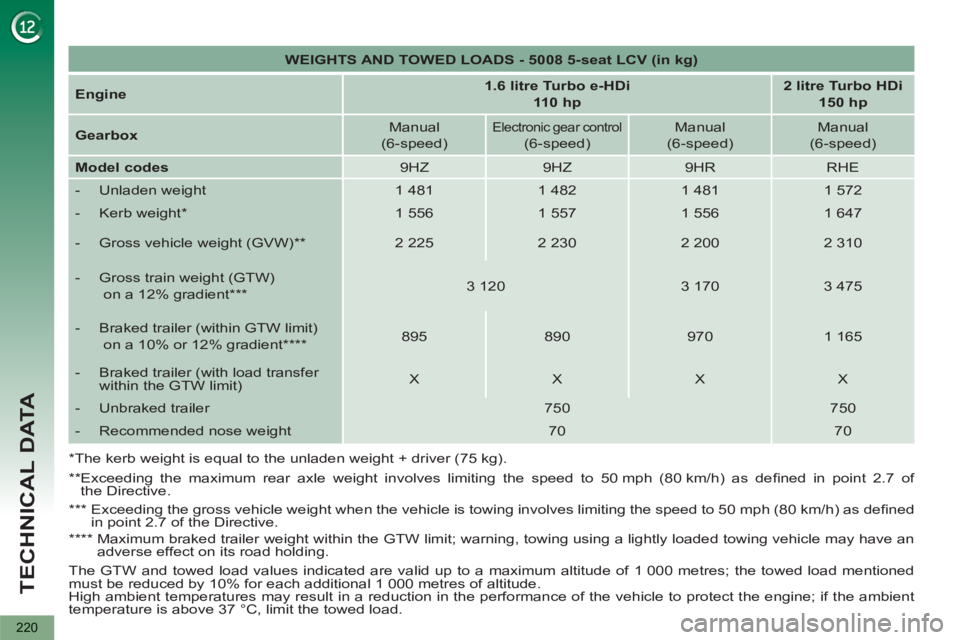
TECHNICAL DATA
220
WEIGHTS AND TOWED LOADS - 5008 5-seat LCV (in kg)
Engine
1.6 litre Turbo e-HDi
110 hp
2 litre Turbo HDi
150 hp
Gearbox
Manual
(6-speed)
Electronic gear control
(6-speed)
Manual
(6-speed)
Manual
(6-speed)
Model codes
9HZ
9HZ
9HR
RHE
- Unladen weight
1 481
1 482
1 481
1 572
- Kerb weight *
1 556
1 557
1 556
1 647
- Gross vehicle weight (GVW) **
2 225
2 230
2 200
2 310
- Gross train weight (GTW)
on a 12% gradient ***
3 120
3 170
3 475
- Braked trailer (within GTW limit)
on a 10% or 12% gradient ****
895
890
970
1 165
- Braked trailer (with load transfer
within the GTW limit)
X
X
X
X
- Unbraked trailer
750
750
- Recommended nose weight
70
70
*
The kerb weight is equal to the unladen weight + driver (75 kg).
**
Exceeding the maximum rear axle weight involves limiting the speed to 50 mph (80 km/h) as defi ned in point 2.7 of
the Directive.
***
Exceeding the gross vehicle weight when the vehicle is towing involves limiting the speed to 50 mph (80 km/h) as defi ned
in point 2.7 of the Directive.
****
Maximum braked trailer weight within the GTW limit; warning, towing using a lightly loaded towing vehicle may have an
adverse effect on its road holding.
The GTW and towed load values indicated are valid up to a maximum altitude of 1 000 metres; the towed load mentioned
must be reduced by 10% for each additional 1 000 metres of altitude.
High ambient temperatures may result in a reduction in the performance of the vehicle to protect the engine; if the ambient
temperature is above 37 °C, limit the towed load.